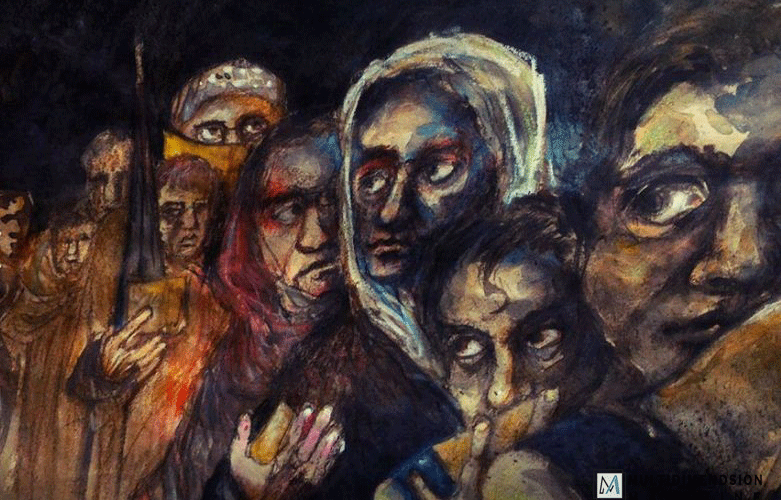Written By: Senex
Paris, France
Illustration: Multidimension Source
Part One – History and problems
Immigration is such a late 20th century word and concept. Quite a meaningless one in the world before WWII but has gained much currency since. The most important reason for that was the end of colonization. Before colonization human migration was an eternal phenomenon since the dawn of time. Classical anthropology tells us that man in his current form evolved in Northeastern Africa some 200 to 350 thousand years ago and some 70 to 80 thousand odd years ago started migrating out of his continent of origin and spread across the planet in every possible direction. Some of these journeys took tens of thousands of years and hundreds of generations, covering distances that today take a commercial jetliner less than a day. It must be noted that the population of all the Homo sapiens in the world 50,000 years ago was less than one small town today.
For the last five centuries we have had a Europe with nation states that had been born out of centuries of warfare and which had more or less created territorial entities that took the name of countries. By the end of the 15th century they had managed to overthrow the Moors (who had ruled for almost 800 years over one of Europe’s strongest nations, Spain) and began their quest to look beyond Europe. The stagnation of the Ottoman Empire in the East was taking place simultaneously. The dominant position of the Europeans forced them to fan outward and invade weaker and, more importantly, richer prey. Thus began the conquest of the newly discovered Americas and search for trade routes to the East. The global hierarchy that resulted from this was a powerful set of European countries that gradually conquered every available piece of territory and relegated its natives to either a slavedom or sent them to the hereafter post-haste. Some of this was brutal and genocidal (the Americas), some of it was by stealth and cunning (India and the East)
WWII brought an end to this setup for various reasons. Altruism on the part of the Europeans was most certainly not one of them. The new world that emerged was restructured in a way that continued to accrue the benefits of colonialism without its burdens and responsibility. How so? Simply because the new world order was designed by the ex-colonial powers led by the USA. This new world order included principally the financial, economic, and the world of trade and commerce. The recognition of nation states as sovereign entities played a very important role in how immigration would be viewed in the future. In the new world order all nation states were viewed as members of an international community. A family of sorts. The concept of Free Trade was reformulated and made to look like an extension of democracy and human rights, and pushed with great vigor. What it really disguised was the huge advantage it had for the first world who had the financial, technological, logistical and administrative wherewithal to carry out a program; whereas developing countries (mostly ex-colonies) had no power to resist a new onslaught on its economies.
Talking about economies, Economics 101 teaches us that all economic production involves the 3 factors of production: land, labour and capital; the output (finished goods and services) being the result. Free trade very cleverly aimed at the complete freedom of movement for all these factors with the exception of labour. Why? Simply because the rich countries (ex-colonizers) could now enjoy all the benefits of colonization without its responsibilities. The new world order demanded that every member open its doors to every other member to come and invest and start companies in their territories. The economic history of the world since WWII shows how such trade benefited the ex-colonizers, who control trade and all the rules and regulations governing it. Who controls the financial structure of the world and who benefits from it… ?
Had labour been allowed the same freedom of movement as capital, resources, finished products and services, there would have been at least a logical justification to the claims of free trade. Now there are none. Instead, we have seen greater and greater barriers to immigration in the OECD countries, but even more to those belonging to its predecessor, the 15 OEEC countries, which were simply the Western European countries that were target of the American Marshall Plan and were sworn to the Market Economy system and “free trade” described above. This entire mechanism to control global trade and commerce was put in place by the USA and its Western European allies even before WWII ended. That the subjugated enemies (Germany, Japan and Italy…) were eventually included in it came as no surprise. They had been members of the elite club before the war.
To maintain and sustain this unjust and illogical system solely for the benefit of the rich and powerful, they had to create a false narrative based on nationalist sentiments which would be easy to sell to the people. They contend that immigration is the source of general decline of the economies, mainly that of employment of the workers; increase in crime and decrease of security; all of which studies overwhelmingly show are wrong. Immigrants have proved time and again to be the most dynamic sector of the population, contributing far more than they consume of a nation’s wealth. The new world was built on the backs of immigrants; the first lot of which were dragged there against their wishes, as slaves.
Looking at Immigration – Part II
The principal reason for maintaining the paradox of the anachronistic nation state in an increasingly globalised world is that it helps the rich and powerful to stay rich and powerful. They can rule and profit in a divided world constantly bickering over such differences. They sustain it by constantly reinforcing differences, using mainly cultural elements that are emotionally embedded, deep within the psyche of the people. Religion, race, colour, language… People never question them because they have acquired so much meaning for them over a long period of time. They never suspect their cynical misuse and abuse. Modi and other politicians creating havoc in Assam by setting the local people against other local people is no different from Trump instigating people in the USA against Mexicans or Le Pen against the Muslims.
Imagine a country like Australia or Canada with population densities of 3 and 4 people per square kilometer, but more importantly, themselves built on genocide, invasion and immigration, denying immigration to even refugees fleeing wars and death. It is an affront to, not just its pretensions of being a humane democracy but an insult to its own history of immigration. At the same time we have countries like Bangladesh with population density of 1152 people per square kilometre, opening its doors to the Rohingya refugees from Myanmar, time and again. Yet, Bangladesh is often vilified as an underdeveloped nation, corrupt and undemocratic, while the “civilised and caring” Australia (along with the other demi-Gods of the human world) is among the honoured, sharing space with other white, Euro-centric people of its kind.
Whichever way we look at it the question of immigration is a burning one in the 21st century and we need to collectively address it. We shall look at the possible answers in our next instalment.




